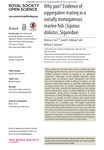Why pair? Evidence of aggregative mating in a socially monogamous marine fish
| dc.contributor.author | J. Fox, Rebecca | en_US |
| dc.contributor.author | R. Bellwood, David | en_US |
| dc.contributor.author | D. Jennions, Michael | en_US |
| dc.date.accessioned | 2016-10-11T05:37:48Z | |
| dc.date.available | 2016-10-11T05:37:48Z | |
| dc.date.issued | 2015 | en_US |
| dc.identifier.other | HPU4160588 | en_US |
| dc.identifier.uri | https://lib.hpu.edu.vn/handle/123456789/23669 | |
| dc.description.abstract | Many species live in stable pairs, usually to breed and raise offspring together, but this cannot be assumed. Establishing whether pairing is based on mating, or an alternative cooperative advantage, can be difficult, especially where species show no obvious sexual dimorphism and where the act of reproduction itself is difficult to observe. In the tropical marine fishes known as rabbitfish (Siganidae), half of extant species live in socially monogamous, territorial pairs. | en_US |
| dc.format.extent | 7 p. | en_US |
| dc.format.mimetype | application/pdf | |
| dc.language.iso | en | en_US |
| dc.subject | Biology | en_US |
| dc.subject | Behaviour | en_US |
| dc.subject | Ecology | en_US |
| dc.subject | Coral reef fish | en_US |
| dc.subject | Pairing | en_US |
| dc.subject | Reproduction | en_US |
| dc.subject | Social systems | en_US |
| dc.subject | Spawning aggregation | en_US |
| dc.title | Why pair? Evidence of aggregative mating in a socially monogamous marine fish | en_US |
| dc.type | Article | en_US |
| dc.size | 556KB | en_US |
| dc.department | Education | en_US |
Files in this item
This item appears in the following Collection(s)
-
Education [806]

